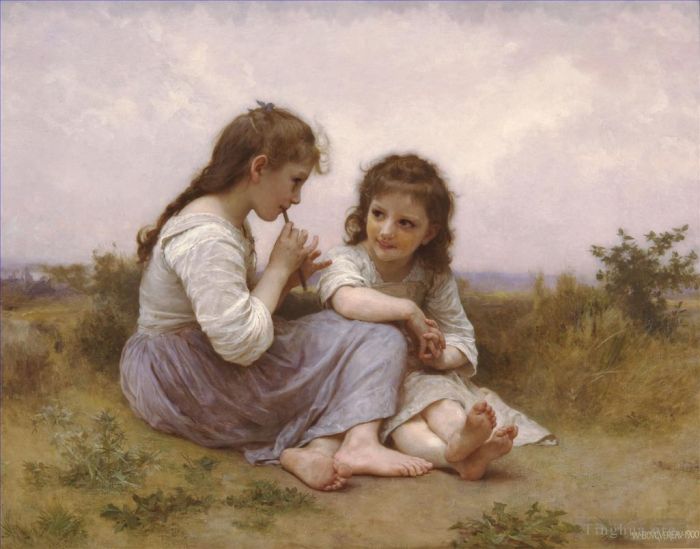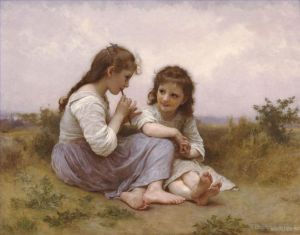A Childhood Idyll
William-Adolphe Bouguereau
- Price: Price on Request
- Art Type: Oil Painting
- Size:
- English Comments: 0
- International Comments: 0
- Creating Date:
- Introduction and Works of William-Adolphe Bouguereau >>
Work Overview
- A Childhood Idyll
William-Adolphe Bouguereau
Date: 1900
Style: Realism
Genre: portrait
Media: oil, canvas
Dimensions: 102 x 130 cm
Location: Denver Art Museum (DAM), Denver, CO, US
An idyll is a poem, prose piece, or event depicting a rural and tranquil scene, usually in idealized terms. The girls in this painting are images of idyllic innocence. Bouguereau probably created this painting during one of his frequent trips to La Rochelle, modeling it after local peasant children. Childhood Idyll reflects the classicism of academic painting in the late 1800s, which referred back to the art of ancient Greece and Rome. Bouguereau made his paintings look timeless: instead of portraying the girls in the latest fashions, he paints them wearing peasant-type clothing that could belong to several different centuries. Bouguereau’s painting process was long and painstaking; this painting is the result of months of dedicated research, sketching, and careful planning.
The artist’s brushwork is virtually invisible. The figures are painted with thin layers of paint and almost no texture, leaving a smooth, glossy finish. There are only a few spots where you can see big fanned brushstrokes in the clouds, and short, wispy brushstrokes in the shrubs.
The perception of depth in nature can be enhanced with the use of atmospheric haze. This effect is achieved by using less focus and dull, blue hues for distant objects. The haze in this painting represents cloudiness, but can also indicate humidity, rain, snow, or smoke.
Foreshortening is a technique artists use to create an illusion of depth, either by pushing an object forward or sending it back into space. Look at how much larger the older girl’s feet are compared to her head, for example. The difference in scale between the two anatomical parts suggests that the feet are closer to the viewer than her head.
Composition is the arrangement of elements in a painting. The three main elements in this painting are the girls, the background, and the foreground grasses and shrubs. Bouguereau places his subjects in a space that’s rather like a stage. The two girls are seated center stage, facing the audience at a comfortable distance. The flat landscape and empty sky create a sense of expansiveness, dividing the background into two distinct spaces—the top and the bottom. Although one has the impression that this artwork was painted out of doors, it was actually a very planned and deliberate composition that the artist worked out in his studio.
Bouguereau gives his painting a rosy glow by using pinks and flesh tones to warm the otherwise cool whites and blues. Even the ground seems reddish. Bouguereau adds white and gray to his colors to give the work its soft, pastel effect.
Except for the dark outlines of the girls’ heads against the light sky, there are no strong lines in the painting. Boundaries are merely implied by subtle color shifts. Soft edges and interwoven colors allow our eyes to flow freely across the painting.
The sunlight in this painting is diffused through the overcast sky, softening and muting the colors.
- Copyright Statement:
All the reproduction of any forms about this work unauthorized by Singing Palette including images, texts and so on will be deemed to be violating the Copyright Laws.
To cite this webpage, please link back here.
- >> English Comments
- >> Chinese Comments
- >> French Comments
- >> German Comments
- >>Report
- Litalienne au tambourin
- Compassion
- Far Niente
- The Return of Spring
- The chilly
- Cupid and Psyche
- Jeune fille allant a la fontaine
- FemmeAuCoquillage 1885
- Jeune italienne puisant de leau
- The Madonna of the Lilies
- The Dance
- Le Baiser 1863
- The Shepherdess
- Reverie
- Girl with bouquet
- Homere et son guide
- The Prisoner
- After the Bath
- Le repos
- Tricoteuse 1879
- Charity
- Jeune ouvriere
- LAmour et Psyche enfants
- Parure des champs
- The Broken Pitcher
- Lady with Glove 1870
- Seated Nude
- Femme Blonde profil 1898
- La tricoteuse
- Adolphe Juene Fille Et Enfant MiCorps
- Portrait de lartiste
- Lidylle
- A Portrait of Leonie
- Idylle 1851
- Etude dune femme pour Offrande a lAmour
- Jeunes bohemiennes
- Le secret
- Le Jeune Bergere 1897
- Soul Carried to Heaven
- Sur la greve
- Temptation 1880
- Maternal Admiration
- The First Mourning
- Le jeune frere 1900
- Unfinished detail
- Sainte Famille
- NotreDame Des Anges
- The Nut Gatherers
- After the Bath
- Madame la Comtesse de Cambaceres
- Madone assise
- Evening Mood (Twilight or Dusk)
- Gabrielle Cot 1890
- Portrait of a Young Girl
- The Birth of Venus
- Cupid with Butterfly
- Work Interrupted
- Une Vocation
- Bohemienne au Tambour de Basque
- Jeune Fille et Enfant
- Etude tete de petite fille tete de petite fille
- Loin du pays
- La Vierge LEnfant Jesus et Saint Jean Baptiste2
- The Mischievous One
- Inspiration
- Le Lever
- Fileuse
- Faneuse
- Washerwomen of Fouesnant 1869
- Paquerettes
- Les Oreades 1902
- Psyche
- Young Woman Contemplating Two Embracing Children
- Boucles DOreilles The earrings 1891
- The Return from the Harvest
- Etude Femme Blondede face 1898
- Study for Vierge aux anges
- TheBather 1879
- Jeunesse Realism angel
- The Virgin with Angels (The Queen of the angels)
- La grappe de raisin
- Marguerite
- La brie du printemps
- La Soupe
- Berceuse
- Brother and Sister
- Au bord du ruisseau
- Psyche et LAmour
- The Nymphaeum
- Vierge consolatrice
- Baigneuse 1870
- Une vocation 1896
- The Youth of Bacchus
- Petite bergere
- A Portrait of Eugene
- Lart et la litterature
- Le Passage du gue
- Un moment repos
- The Heart’s Awakening
- La Charite 1859
- The Madonna of the Roses
- The Young Shepherdess
- Calinerie
- The Storm
- La bourrique oil on canvas
- Branche de laurier
- Le jour (Day)
- La reverence
- Mailice
- Lady Maxwell 1890
- Little beggars
- Avant le bain
- Jeune bergere 1868
- La vague
- Adolphe MAUVAISE ECOLIERE
- La priere
- Le gouter
- Pieta 1876
- Will8iam Dante et Virgile au Enfers
- The Goose Girl 1891
- Linnocence
- La Vierge LEnfant Jesus et Saint Jean Baptiste
- Beaute Romane 1904
- Loves Resistance 1885
- Moissoneuse
- The Motherland (Alma Parens)
- Reve de printemps
- A Portrait of Amelina Dufaud
- Unknown
- The Bohemian
- Portrait of a young girl 1896
- Irene
- Meditation
- The Assault
- Priestess
- La soeur ainee
- Day 1881
- The Shell
- La Vierge a Lagneau
- Bergere
- Orestes Pursued by the Furies
- Tobias Saying Goodbye to his Father 1860
- La lecon difficile
- Douleur damour
- Frere et Soeur
- Le jeune frere
- Bergere 1886
- Laurore
- Le retour du marche
- Petite boudeuse
- Song of the Angels (Virgin of the Angels)
- En penitence
- Le Crab
- La Petite Mendiante
- La soif
- The Shepherdess 1873
- The Invasion
- Petites maraudeuses
- Girl Holding Lemons 1899
- Zenobia Found by Shepherds
- Portrait Of Genevieve Celine Eldest Dau
- Flight of Love
- La Charite Romaine
- Portrait de Mlle Brissac
- Les pommes
- La palme
- Nymphs and Satyr
- Reflexion
- Flagellation of Our Lord Jesus Christ
- Wet Cupid
- The Abduction of Psyche
- The Bathers (The Two Bathers)
- Le jour des morts
- Ladmiration
- Les Jeunes Baigneuses
- Child Braiding A Crown
- Slumber
- The Little Marauder 1900
- The Pastoral Recreation 1868
- Mignon Pensive
- Unknown1
- The Knitting Girl
- Yvonne
- Meditation 1885
- Frere et soeur bretons
- Unfinished
- Biblis
- Portrait Of Madame Olry Roederer
- A Childhood Idyll
- La Gue
- Fardeau agreable
- La jeunesse de Bacchus centre dt
- The Thank Offering
- Jeune fille se defendant contre lamour
- Etude Tete de Jeune fille
- Retour des champs
- Lost Pleiad
- Les prunes
- Portrait de Mademoiselle Elizabeth Gardner
- Amour a laffut angel
- Harvester (The Grape Picker)
- La Comtesse de Montholon
- A la fontaine
- Portrait of a Young Girl Crocheting
- A Portrait of Genevieve
- La couturiere
- Femme de Cervara et Son Enfant 1861
- Modestie
- Deux soeurs
- Drawing of a Woman
- Night
- Mars
- Laurore Realism WilliamAdolphe
- Flagellation of Christ study in pencil
- Study of a Seated Veiled Female Figure









 Singing Palette
Singing Palette